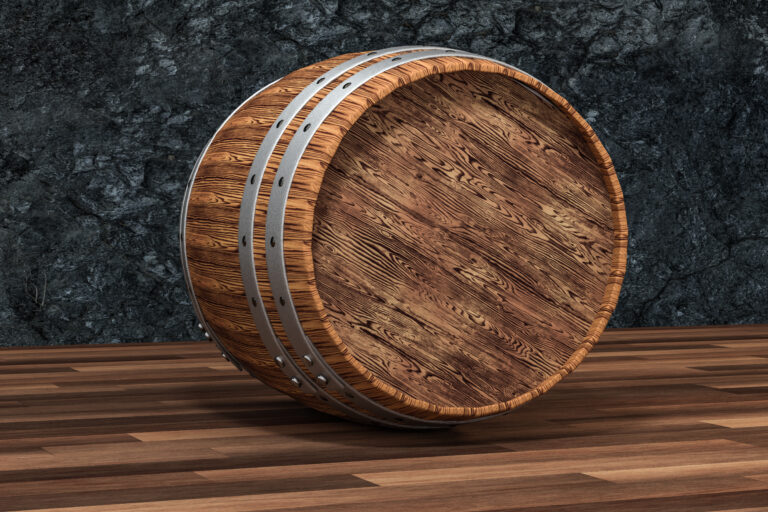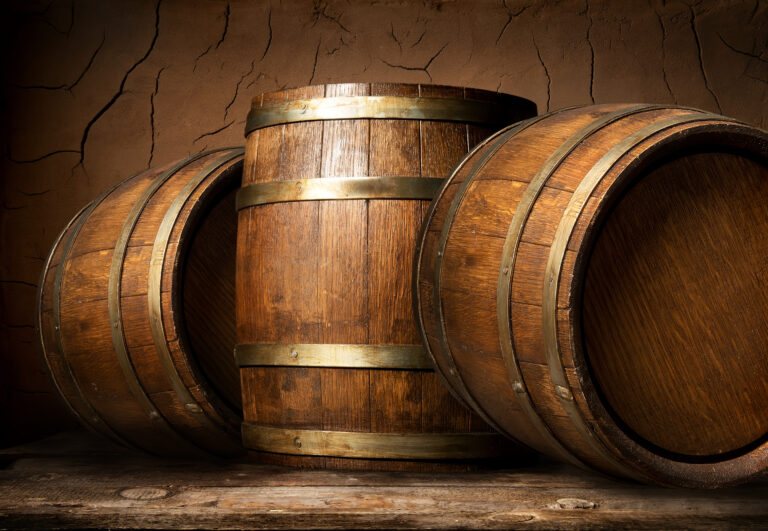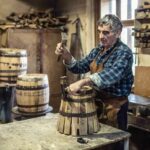Whiskey lovers, ever wonder how your favorite aged whiskey gets its distinctive flavor and aroma? It’s more than just the grain bill or yeast strain; it’s profoundly shaped by how the spirit matures in its wooden home. Distillers, those ingenious alchemists, have been pushing the boundaries lately with groundbreaking barrel designs that dramatically impact the whiskey aging process.
For centuries, the stalwart oak barrel has been the industry’s workhorse. But now, innovative whiskey makers are venturing beyond tradition, exploring diverse wood types, unconventional barrel shapes, and ingenious ways to alter the interior surface of their casks. These novel barrels are imparting unique flavors and aromas, completely redefining our understanding of what a truly distinctive aged whiskey can taste like. So, buckle up and read on to explore how cutting-edge barrel design is sculpting the bold, new, and utterly exciting flavor profiles of whiskey.
Traditional Barrel Design and Its Enduring Role in Whiskey Aging
The classic vessel for whiskey maturation has been the oak barrel for hundreds of years. Charred oak barrels, in particular, have been the unsung heroes, instrumental in imbuing countless famous whiskeys with their signature taste and aromatic charm.
The Profound Impact of Oak and Char
Oak barrels aren’t just containers; they’re active participants, generously imparting vanillin and a treasure trove of other flavor compounds to the whiskey as it gracefully ages. The charred inner surface of these barrels is equally vital, contributing significantly to the whiskey’s distinctive taste. As the spirit breathes and expands into the very fabric of the wood, that magical char layer acts as a natural filter, refining and mellowing the whiskey to perfection.
- Oak tannins bestow a pleasant astringency and that gorgeous reddish hue upon the whiskey. These tannins are clever, binding to proteins and other compounds, essentially dropping them out of suspension, leading to a clearer, more polished spirit.
- Lignins nestled within the oak orchestrate a delightful breakdown, giving rise to luscious vanilla and clove flavors.
- Oak lactones are responsible for those enticing coconut aromas that many bourbons and whiskeys boast.
- The charcoal filtering provided by the char helps banish harsh flavors, like unwanted sulfur notes, making for a smoother sip.
- Even the act of toasting the oak staves before they’re meticulously bent into barrels is a flavor creator, conjuring up additional, complex flavor compounds.
When whiskey emerges from its long slumber in charred oak barrels, it’s a symphony of vanilla, caramel, coconut, and spice notes, all wrapped in a mesmerizing amber color. The charred wood isn’t just about flavor; it naturally filters the spirit, contributing significantly to its remarkable smoothness.
The Influence of Barrel Size and Design on Flavor Development
The sheer size and nuanced shape of whiskey barrels dramatically influence both the pace of whiskey aging and the depth of its flavor development. Consider this: smaller barrels, with their greater surface area to volume ratio, like those typically employed in bourbon production, tend to mature whiskey more rapidly. Contrast that with Scotch whisky, which often uses much larger barrels, leading to a characteristically longer aging period.
- American white oak barrels are prized for their higher porosity, allowing for a more pronounced flavor transfer compared to European oak. This is why white oak is the gold standard for many bourbons.
- Factors like barrel thickness, the specific wood source, the level of char, and even the aging environment (think climate and humidity) all play a critical role in shaping the final flavor profile.
- The exciting world of non-traditional barrel designs and diverse wood types is now yielding truly distinctive new flavors. It’s no surprise that used bourbon or sherry barrels are incredibly popular for finishing scotches and whiskeys, adding layers of complexity.
Ultimately, innovations in barrel design are enriching the timeless partnership between oak, char, and whiskey. Master distillers now wield unprecedented control over flavor creation. While oak and char remain the defining hallmarks of exceptional whiskey, the horizon of experimentation is truly boundless.
The Intricate Science Behind Wood and Whiskey Interaction
The captivating interplay between wood and whiskey during its aging process is a marvel of scientific complexity. For decades, charred American white oak barrels have been the industry’s unwavering benchmark, consistently imparting those beloved vanilla, caramel, and spice flavors. But a new wave of innovative barrel designs is truly changing the game.
Unveiling New Wood Types for Whiskey Aging
Distillers are boldly venturing into uncharted territory, experimenting with an exciting array of different wood types, such as hickory, maple, and chestnut. Each of these woods, a unique personality in itself, imparts its own set of unique flavors to the whiskey. Hickory might contribute smoky, nutty notes, while maple lends a subtle, natural sweetness. These non-traditional woods are flinging open the doors to an entirely new universe of flavor possibilities for the discerning whiskey palate.
The Art and Science of Barrel Char
The precise level of char on the inside of the barrels is a pivotal factor in shaping the whiskey’s flavor. Lightly charred barrels tend to produce more delicate, subtle effects, allowing other nuances to shine. Conversely, heavily charred barrels are flavor powerhouses, imparting more robust, pronounced smoky characteristics. Some visionary distillers are even employing barrels with a “double char” for an extra punch of smokiness and depth.
The Significance of Barrel Size in Maturation
It’s simple arithmetic: smaller barrels mean more intimate wood contact for the whiskey. This translates to faster aging and a more rapid development of pronounced wood flavors. Many agile craft distillers are cleverly utilizing smaller 5- to 15-gallon barrels to accelerate the aging process and meticulously craft truly distinctive flavor profiles. In contrast, larger barrels embrace a slower, more gradual flavor infusion and maturation, allowing for a deeper, more nuanced evolution of the spirit.
These pioneering innovations in barrel design are empowering whiskey makers to meticulously craft spirits with truly unique, tailored flavor profiles. By artfully experimenting with diverse wood types, char levels, and barrel sizes, distillers now command an expanded, vibrant palette of flavors to work with. The exciting outcome? A thrilling new world of whiskey that’s just begging to be savored. Cheers to the innovators who are fearlessly pushing the boundaries of barrel aging!
Unpacking the Limitations of Traditional Barrel Design
While revered for centuries, the traditional barrel design used for whiskey aging does come with its inherent limitations. For ages, charred oak barrels have been the unchallenged standard, but now, a new wave of distillers are boldly experimenting with different woods and barrel shapes to unlock truly unique flavors.
- Though oak barrels are undoubtedly superb for mellowing whiskey, they can impart strong oak flavors that, at times, might overshadow other delicate notes. This is where alternative woods like maple, hickory, and chestnut step in, allowing more subtle flavors to blossom. These woods also excel at coaxing out delightful fruity esters and intriguing spice notes in the whiskey.
- The standard barrel shape isn’t the most efficient for aging spirits. With barrels typically wider in the middle, less surface area is in direct contact with the whiskey, leading to slower maturation. This challenge has led some distillers to embrace barrels with a more bulbous shape, ingeniously providing up to 50% more surface area. This means flavors are extracted at a faster clip, allowing distillers to age whiskey in roughly half the time!
- While steeped in tradition, wooden barrels are susceptible to leaking over time as the wood naturally expands and contracts. This regrettable phenomenon leads to the loss of some precious whiskey to evaporation during aging, famously known as the “angel’s share”. This is where barrels made of inert materials like stainless steel could offer a solution, potentially eliminating this loss. While certainly unconventional, these barrels can still allow essential oxygen to interact with the whiskey, contributing to the spirit’s mellowing and maturation.
- Standard barrels, typically holding 53 gallons, can sometimes limit the scope of experimentation. This has spurred the rising popularity of smaller barrel sizes, ranging from a nimble 5 to 30 gallons. The reduced size means the whiskey enjoys greater surface area exposure, dramatically accelerating maturation. This allows distillers to swiftly produce specialty and experimental batches, making it ideal for pioneering new flavor profiles. The smaller format is also perfectly suited for home aging kits, inviting enthusiasts into the world of DIY whiskey maturation.
Expect to see an exciting surge in the diversity of barrels and aging techniques in the years to come. While traditional methods have undeniably endured for good reason, a courageous willingness to push boundaries will undoubtedly unlock a whole new universe of flavors just waiting to be discovered in a glass of whiskey. The future of barrel-aged spirits looks incredibly promising indeed.
Innovations in Barrel Char and Toasting Methods
The art and science of barrel charring and toasting techniques have truly evolved far beyond the early days of whiskey production. Today, master distillers are diligently experimenting with novel methods to impart even more intricate and complex flavors to their aged spirits.
Advanced Barrel Charring Techniques
The iconic charred oak barrel remains absolutely integral to the distinctive character of bourbon. Historically, the inside of barrels was simply burned just enough to char the wood before being filled. Now, however, some innovative distillers are employing more sophisticated charring techniques, such as convection and gas-firing, to achieve deeper, more consistent char layers. Deeper chars translate to significantly more surface area for the whiskey to interact with, ultimately resulting in bolder flavors like rich chocolate, coffee, and spice notes.
The Nuances of Barrel Toasting
Toasting refers to the deliberate heating of the barrel staves before charring, a process designed to caramelize the wood sugars. The longer and hotter the toast, the more robust and pronounced the flavors imparted to the whiskey. Some visionary distillers are toasting barrels for as long as 2 hours to produce an exquisite amber color and notes of rich butterscotch or maple in the finished spirit. The masterful combination of heavy toasting and lighter charring creates barrels that yield particularly sweet, almost dessert-like flavor profiles.
The Rise of Hybrid Barrels
A truly intriguing development is the use of hybrid barrels. Some distillers are ingeniously aging whiskey in used barrels from other spirits, such as rum, tequila, port, or sherry, to craft truly unique flavor profiles. Others are meticulously constructing custom hybrid barrels using staves from various wood types, like oak, hickory, or maple. This thoughtful blend of woods contributes to a more aromatic complexity in the finished whiskey. These inventive aging techniques are empowering craft distillers to create genuinely distinctive, terroir-driven spirits.
While the traditional charred oak barrel will undoubtedly remain a cornerstone for most whiskeys, a new era of barrel designs and aging methods is transforming the entire category. As distillers gain increasingly precise control over variables like wood type, char level, and toast length, the incredible range of flavors found in aged spirits is set to expand exponentially. Whiskey lovers can eagerly anticipate an even more diverse array of distinctive, truly complex drams to discover.
Smaller Barrels: A Shortcut to Faster Maturation
It’s a simple truth in the world of whiskey aging: smaller barrels mean a greater surface area for the whiskey to intimately interact with the wood. This translates directly to faster maturation and a quicker path to a polished finish. Many enterprising distilleries are now actively experimenting with smaller barrels to produce whiskey with truly distinctive flavor profiles in a fraction of the traditional time.
The Power of 5-10 Gallon Barrels
Barrels of this size, often affectionately dubbed “micro barrels,” are absolute game-changers, dramatically accelerating maturation. The significantly higher surface area to volume ratio ensures the whiskey picks up oak flavors and aromas at an astonishingly accelerated pace. Whiskeys aged in 5-10 gallon barrels can be ready for enjoyment in just 6-18 months, a stark contrast to the years, or even decades, required for their larger counterparts. The trade-off? They tend to impart oak flavors very rapidly, and the whiskey can become over-oaked if left in for too long without careful monitoring. Nevertheless, micro barrels are a fantastic option for home aging kits, allowing hobbyists to craft their own aged whiskey right at home.
The Versatility of 15 Gallon Barrels
Slightly larger than micro barrels, 15-gallon barrels also speed up maturation thanks to their impressive surface area to volume ratio. Many dynamic craft distilleries rely on 15-gallon barrels to rapidly age and finish their whiskeys within 1-3 years. The whiskey absorbs oak flavors at a brisk pace, so careful oversight is essential to prevent over-oaking. The delightful result is a distinctly flavored whiskey in a refreshingly short amount of time.
Finding Balance with 30 Gallon Barrels
Mid-sized barrels like these strike a beautiful balance between accelerated maturation and a more traditional aging experience. With more volume than smaller barrels but still ample surface area, 30-gallon barrels can impart noticeable oak character within 2-5 years. The whiskey has enough time to mellow and develop complexity, but at a faster clip than in sprawling large barrels. Many esteemed whiskey brands cleverly finish or blend components aged in a variety of barrel sizes to create their signature, truly distinctive flavors.
Ultimately, smaller barrels are providing innovative and exciting options for crafting whiskey. By masterfully manipulating time and the oak influence, distillers now wield more control over flavor than ever before. The exhilarating outcome is an explosion of unique and intensely flavored whiskeys for enthusiasts to eagerly explore.
Alternative Wood Types for Unique Flavors
As the whiskey industry continues its relentless march of innovation, forward-thinking distillers are boldly experimenting with a diverse array of wood types for their barrels, all in pursuit of truly unique flavors. Beyond the revered traditional American white oak and European oak barrels, fascinating alternative woods are now being harnessed to age whiskey and forge remarkably distinctive tasting profiles.
- Maple wood barrels are a sweet secret, imparting a subtle maple syrup flavor and a delightful natural sweetness. The wood’s tight grain and low tannins contribute to a lighter, smoother whiskey. Several intrepid craft distilleries across the U.S. and Canada are now successfully aging whiskey in maple wood.
- Hickory wood barrels are for those who crave a robust, smoky flavor, thanks to the wood’s higher tannin content. The bold, spicy notes of hickory pair exceptionally well with rye whiskeys. A handful of small distilleries in the Southern U.S. are pioneering hickory-aged whiskey, though its potent flavor may be an acquired taste for some.
- Apple, cherry, and peach wood barrels bring a fresh, wonderfully fruity aroma and taste to the party. These softer, more porous woods naturally speed up the aging process, infusing whiskey with delightful sweet stone fruit flavors in a mere 6-12 months. Several distilleries have unveiled limited-edition fruitwood-aged whiskeys to widespread acclaim. However, the wood’s relatively short lifespan and intense flavor might make it better suited as a finishing barrel rather than a primary aging vessel.
- Mesquite wood barrels produce an intensely smoky, earthy whiskey with captivating notes of molasses and spice. This hard, resinous wood is abundant in Texas and the Southwest, where a handful of innovative craft distilleries are experimenting with mesquite-aged whiskeys. Its robust flavor is particularly ideal for aging bourbon and rye.
While traditional oak barrels will undoubtedly continue to dominate the whiskey industry, alternative wood barrels represent a truly promising frontier of innovation. As more distilleries release whiskeys aged in unique, regional wood types, consumers are being treated to an expanding array of new and truly distinctive flavors. The sheer variety of woods now employed to age whiskey is a beautiful reflection of the growing artistry and boundless creativity fueling today’s vibrant craft spirits renaissance.
Tech-Driven Barrel Alternatives: Oxygenation and Ultrasound in Whiskey Aging
The landscape of whiskey aging is undergoing a rapid transformation, propelled by tech-driven barrel alternatives. Some forward-thinking distilleries are harnessing the power of oxygenation and ultrasound to dramatically accelerate the maturation process.
The Science of Oxygenation in Whiskey
Oxygenation involves deliberately exposing the whiskey to oxygen at an accelerated rate. This process ingeniously mimics the effects of traditional barrel aging by triggering chemical reactions that produce those coveted barrel-aged flavors like vanilla, caramel, and oak in just a matter of days. The whiskey is typically pumped through tubes while oxygen is carefully bubbled through it. Some distilleries boldly claim that oxygenation can produce a 10-year-old whiskey in as little as 10 days. However, critics argue that it often lacks the deep complexity of flavor that naturally develops over genuine, long-term barrel aging.
Harnessing Ultrasound for Faster Whiskey Maturation
Ultrasound technology employs high-frequency sound waves to create microscopic bubbles within the whiskey. These bubbles then expand and collapse, dramatically speeding up the interaction between the whiskey and the wood. The ultrasonic energy causes the wood itself to vibrate at a high frequency, releasing its flavor compounds into the whiskey at an astonishingly faster rate than normal. Some distilleries are aging whiskey with ultrasound in just a few days to yield a product with a similar flavor profile to one aged for years in traditional barrels. Like oxygenation, ultrasound aims to accelerate a natural process, but it may not fully replicate the intricate complexity achieved through long-term barrel aging.
While these technology-driven aging methods remain somewhat controversial within the whiskey world, they undeniably show immense potential for rapidly producing whiskey with compelling barrel-aged characteristics. However, it’s widely acknowledged that these alternatives likely cannot perfectly replicate the rich, nuanced flavor profiles that meticulously develop over many years of maturation in charred oak barrels. For now, most whiskey connoisseurs will probably continue to gravitate towards traditionally barrel-aged spirits. Yet, as global whiskey demand continues its steady ascent, tech-driven aging could play a crucial role in supplementing dwindling barrel stocks and fostering even greater experimentation. The future of whiskey aging is an exciting blend of cutting-edge science and time-honored tradition.
How New Barrel Designs Sculpt Different Flavor Profiles
The exciting realm of new oak barrel designs is fundamentally altering how whiskey ages and, consequently, the resulting flavor profiles. Innovative cooperages are relentlessly experimenting with diverse oak species, levels of char, and barrel sizes. Here’s a peek into some of the groundbreaking innovative barrel designs that are yielding truly distinctive new whiskeys:
The Accelerated Maturation of Small Barrels
Smaller barrels, such as the nimble 5-10 gallon barrels, dramatically amplify the surface area to volume ratio. This crucial aspect allows the whiskey to interact much more intensely with the wood, accelerating both aging and flavor extraction. The delightful outcome is a whiskey bursting with robust oak, caramel, and spice notes in a surprisingly short 6-12 months. Several pioneering craft distilleries are cleverly utilizing small barrels to swiftly produce truly distinctive aged whiskeys.
The Artful Fusion of Hybrid Barrels
Some ingenious coopers are meticulously crafting barrels using staves from different oak species, such as both French and American oak. This thoughtful mixture of oak varieties within a single barrel creates whiskeys that boast a harmonious blend of flavor notes from each oak. For instance, a blend of French and American oak could yield a whiskey with inviting aromas of vanilla and coconut from the American oak and delicate candied fruit notes from the French oak.
The Complexity of Double Barrels
Finishing a whiskey in a second, smaller barrel is a burgeoning and popular technique that adds layers of complexity. The whiskey first undergoes its initial aging in a traditional barrel, and then it’s carefully transferred into a smaller barrel made of a different oak, perhaps French oak. This second aging phase in the smaller barrel masterfully infuses the whiskey with additional oak character and flavor notes, all while mellowing and rounding out the overall flavor profile. Many astute craft distillers are embracing double barreling to create truly unique aged whiskeys with captivatingly complex flavors.
The Boldness of Heavily Charred Barrels
Certain coopers are producing barrels with a particularly intense char, reaching levels 4 or 5, before they are filled with whiskey. The dark, heavily charred interior of these barrels imbues the whiskey with bold smoky, spicy, and even burnt flavors, alongside the traditional oak and caramel notes. These full-bodied, smoky whiskeys are finding a devoted following among those who appreciate more robust, non-traditional bourbons and whiskies.
With such a vibrant array of new barrel designs now available, distillers have an unprecedented arsenal of ways to experiment with innovative aging techniques and bring to life truly distinctive new whiskeys. The thrilling result is an explosion of unique aged spirits with wonderfully complex flavors for whiskey lovers to savor and explore.
The Future of Whiskey Innovation: What’s Next for Barrel Aging
The horizon of barrel aging gleams with promising innovations. Visionary distillers are ceaselessly experimenting with audacious barrel designs, novel wood types, and cleverly controlled aging environments to meticulously craft truly unique flavor profiles.
Exploring Wood Alternatives in Whiskey Production
Beyond the venerable standard oak, distillers are bravely venturing into aging whiskey in barrels fashioned from other wood types, including maple, hickory, and even redwood. These alternative woods bestow different flavors, aromas, and colors upon the whiskey. While agile small craft distilleries are currently leading this exciting charge, larger brands may well follow suit if these pioneering efforts prove to be successful.
Manipulating Temperature for Accelerated Aging
Some ingenious distillers are actively manipulating barrel temperatures during the aging process to intensify the interaction between the whiskey and the wood. Heating the barrels causes the wood to expand, allowing the whiskey to penetrate deeper into its grain. Conversely, cooling the barrels causes the wood to contract, effectively squeezing out beneficial chemical compounds from the wood back into the whiskey. Cycling between heating and cooling not only speeds up the aging process but also contributes to the creation of truly distinctive flavors.
The Precision of Barrel Char and Toast Levels
The precise level of char or toast on the inside of whiskey barrels profoundly influences its flavor. Darker chars tend to impart a more pronounced smoky flavor to whiskeys, while lighter toasts yield more subtle, nuanced wood notes. Distillers are now experimenting with an array of different char and toast levels, sometimes even within the very same barrel. Imagine: they might heavily char one end of a barrel and lightly toast the other, orchestrating a diverse symphony of flavors from a single batch.
Redefining Barrel Size and Shape
The size and shape of barrels also significantly impacts how whiskeys age. While it seems counterintuitive, larger barrels (in terms of internal surface area to volume ratio) can actually lead to faster aging. Non-traditional barrel shapes, such as square or rectangular designs, naturally offer more surface area for whiskey contact than traditional round barrels. Some distillers are even experimenting with aging whiskey in barrel fragments and staves to maximize the critical wood interaction.
Whiskey makers are perpetually innovating, driven by the growing global demand for unique and complex flavors. New barrel designs, diverse wood types, and sophisticated aging techniques are all part of an exhilarating new chapter in the rich history of whiskey. The future of barrel aging is wide open, promising a universe of delightful discoveries.
Final Thoughts on Whiskey’s Evolving Flavor Journey
So, the next time you raise a glass of your cherished bourbon or Scotch, take a moment to truly appreciate the immense thought and boundless innovation that have gone into aging it to absolute perfection. While time-honored tradition undeniably holds a sacred place in the art of whiskey making, cutting-edge new technologies are now playing a pivotal role in crafting even more extraordinary spirits.
The thrilling experiments unfolding at distilleries – with their adventurous explorations of different barrel types, sizes, and wood treatments – are nothing short of exciting. Who knows what incredible, previously unimaginable complex flavors they’ll manage to coax out of those wooden vessels in the years to come? One thing is for certain, though: as long as there are passionate whiskey drinkers, dedicated distillers will continue to innovate tirelessly, striving to create that perfect, soul-satisfying dram. The future of whiskey is undeniably bright, my friends – here’s a hearty toast to progress, and to the endless possibilities in every sip!







